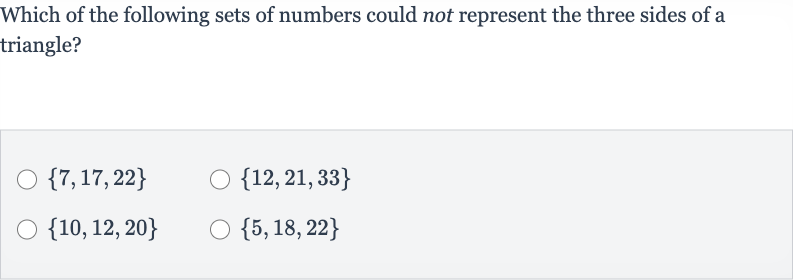Full solution
Q. Which of the following sets of numbers could not represent the three sides of a triangle?
- Recall Triangle Inequality Theorem: Recall the Triangle Inequality Theorem which states that the sum of the lengths of any two sides of a triangle must be greater than the length of the third side.
- Check First Set: Check the first set of numbers to see if they satisfy the Triangle Inequality Theorem.7 + 17 > 22 (24 > 22) - True7 + 22 > 17 (29 > 17) - True17 + 22 > 7 (39 > 7) - TrueAll conditions are satisfied, so could represent the sides of a triangle.
- Check Second Set: Check the second set of numbers to see if they satisfy the Triangle Inequality Theorem.12 + 21 > 33 (33 > 33) - False, the sum is equal to the third side, not greater.12 + 33 > 21 (45 > 21) - True21 + 33 > 12 (54 > 12) - TrueThe first condition is not satisfied, so could not represent the sides of a triangle.
- Conclusion: Since we have found a set that does not satisfy the Triangle Inequality Theorem, we can conclude that could not represent the sides of a triangle. There is no need to check the remaining sets.
More problems from Checkpoint: Rational and irrational numbers
QuestionGet tutor help
QuestionGet tutor help
QuestionGet tutor help
QuestionGet tutor help
QuestionGet tutor help
QuestionGet tutor help
QuestionGet tutor help

